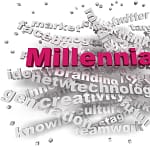What evidence do we have that this trend exists?
It’s no surprise that our workplace is changing, the UK Commission for Employment and Skills (February 2014) proclaimed that “the future workplace will be multi-generational, with four generations working side-by-side. Traditional notions of hierarchy and seniority will become less important”. In fact, research by Condeco Software found that 75% of the workforce will be millennials by 2025, and it is the employee’s responsibility to adapt the workplace to them. ‘Millennials’ are known as the generation born between approximately the early 1980’s and the early 2000’s.
Different generations think differently and have different motivations and expectations – what drives one generation will not always be the same for the next and this complicates the future of our workplace, and how employees respond to these trends.
Two key research papers help us understand how important the link between engagement and wellbeing really is. The first is from the UK Commission for Employment and Skills (UKCES) report on the Future of Work (2014). They claim “[HR Departments] will need to care for the wellbeing of employees, including health and personal issues, to ensure a happy and productive workforce. As a result of these demands, precautionary health services will be a growing job market”.
The CIPD’s report, ‘2013/14 CIPD Employee Outlook survey’ reveals that “when asked to identify at least one benefit [of extending their working life], 26% of respondents confirmed improved personal wellbeing”. So employees see continuing at work to a later age as an element of enhancing their own personal wellbeing. This demonstrates that whether it is the growth of the millennial generation or the increase in people extending their working life, there is significant evidence for us to consider wellbeing when thinking about demographic change in the workplace.
Let’s take some examples, taken from the UKCES report in February 2014:
An aging working population – “With the average age of the UK’s labour force increasing over the coming decade, today’s largest age band of workers is set to shift from 44-46 to 54-56 by 2020”. We see great examples at McDonalds and B&Q where recruitment is focused on increasing the number of older workers and seeing huge business benefits in doing so.
An increasing number of women in the workplace – “An increasing number of women will enter the workforce over the coming two decades with 56% of the net increase in jobs between 2010 and 2020 expected to be filled by women”.
The impact of having multiple generations at work – “Better work-life balance is becoming increasingly important. Generation Y will further drive this trend, 92% of them place flexibility as a top priority when selecting workplaces”. Generation Y is another name for the generation outlined earlier known as ‘Millennials’.
What questions for wellbeing and engagement does this trend provoke?
Wellbeing covers both physical and psychological health. It is about our minds as well as our bodies and our approach should be to centre on building resilience and preventing ill-health rather than only taking action when the damage is done.
Organisations of all sizes should be asking:
- What flexible working arrangements will we need to consider? We will need a greater range of flexible working arrangements to cater for different generations and increasing number of women entering the workforce. So how do we prepare ourselves?
- The aging population leads to increasing demands in care occupations – what impact will this have on the wellbeing offering from employers for all employers, regardless of sector? What will employees increasingly be demanding from their employer and in the workplace? How will this impact an employee’s engagement to where they work?
- How can you equip people with skills in the changing workplace without compromising their wellbeing? What can organisations do to increase resilience of the organisation and their people to sustain their wellbeing?
- How can you elevate the importance and status of the individual’s ‘cultural fit’ to ensure an appropriate level of consideration and investment in people’s mental health?
- What precautionary health services does an organisation need to consider introducing to support employee’s wellbeing and ultimately their engagement? If prevention is better than care, what health promotion should an organisation be focusing on?
- How are organisations gathering data to predict or know what their workforces will look like in the future? It is predicted that job roles will need to change based on future developments in technology and working environment.
How are organisations responding?
BT had a long-serving workforce in their network exchange engineers. Five years ago there were 8,000 engineers managing 5,000 exchanges across the UK; there are now a quarter of the staff managing the same number of exchanges. Exacerbating this, there has been a massive impact on the business via new technologies which impacts skill levels and also is a large cultural change for the employees as 55-65% of them have been with BT for over 30 years.
BT’s response was to embark on a major cultural change programme over 18 months. The key was leading from a values perspective and a strong acknowledgement that these employees (generationally) had seen it all before. Therefore there was a focus on leading by example and being visible.
DIY Retailer B&Q focus their recruitment strategy on a diverse age range and specifically on workers of older generations. They appreciate that an age diverse workforce brings with it a wealth of skills and experience. A case study on www.employeebenefits.co.uk states that 28% of B&Q’s workforce is over the age of 50, the eldest being 96 who works on their checkouts.
The case study states that “the firm recognises that an ageing population comes with some physical restrictions, for example injuries, bad backs and people becoming more frail, so it offers adjustments to utilise these people as well as it can.” This enables workers of an older generation to continue working, appreciating that their wellbeing needs may be different to those of other generations.
So what can you do?
- Improve your understanding of your people profile – do you know the demographics of your employee population? (people metrics/analytics) – this can help you to understand and predict what the wellbeing demands of your employees might be in the future so that your organisation can plan accordingly.
- Research, prepare and consult your employees – research into precautionary health care/health promotion for your organisation so that you can be ahead of the curve. Use your employee demographics to identify the wellbeing initiatives that may be key for your organisation. How will these support your engagement agenda?
- Consider resilience and mental health – consider how best to support people to increase their personal resilience levels. With the growing prevalence of mental health issues, resilience at work and in someone’s personal life becomes even more important.




